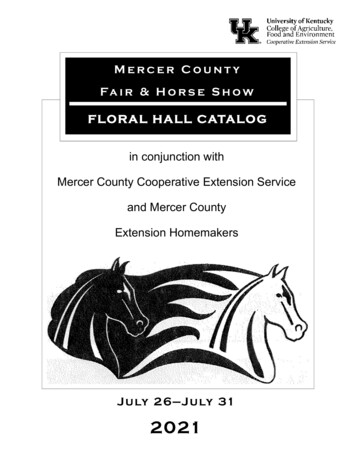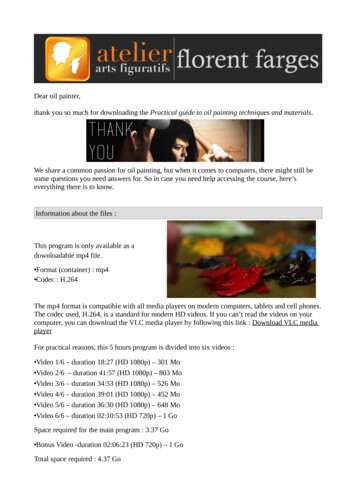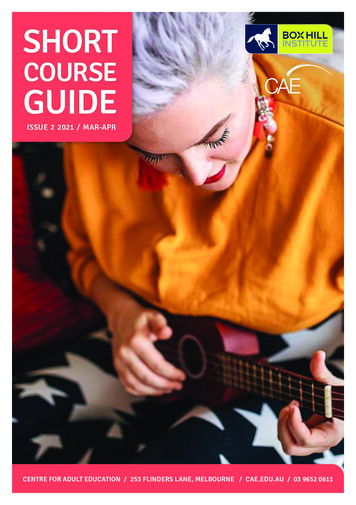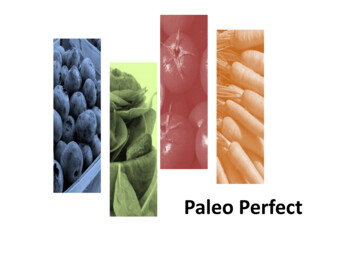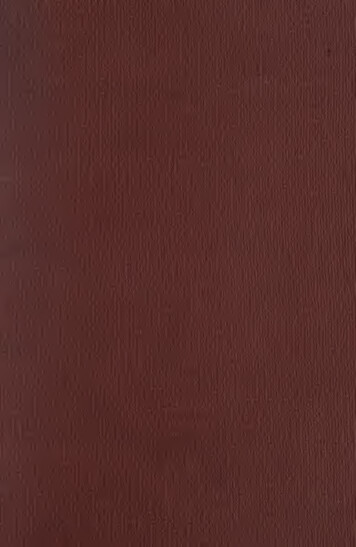
Transcription
*t
*
THE TEACHEROIL PAINTINGand TAPESTRYTHIRD EDITIONBYDEM. CAMPANACHICAGOASPm/
*»APN 24Cl A 7 7 86
Chapter IPREFACEThis book is full of useful suggestions, it will save youtime it will explain many points that take a long time tolearn, but you must work. Practical, steady work, firstlyadequate to your primary knowledge, progressing, continu ous. That is your best work. Then comes the book ofinstructions. Begin and follow up your work step by step.Do not feel overconfident, as it generally ends bad. Inspeaking of books of instruction, do not forget that you areyour own first book, be it in Art, in Sciences, in Music, orany other branch of work. Books show you the way, butyou must do the work. Books help you in acquiring knowl edge much as the hammer helps in driving a nail, but youmust do the hammering.If you wish to learn, begin in an easy manner, the sameas children begin from the first grade reader, and in thisway you will not become discouraged over your unsuccess ful attempts. At first copy a simple object, a tree, a flower,fruit, etc., and do not have the presumption that becauseyour will is strong and you are determined to do thingsyou have the ability to do so. Remember that any sub ject can hardly be too simple or have too little interestingmaterials, as it constantly happens that there is in every thing enough matter for good compositions. It is better,as we mentioned before, to measure your own ability andstart from the bottom, rising gradually to subjects moreand more difficult. Do not consider any subject too com mon foh your efforts. All intricacies and perplexity in workare hindrance to progress. Consequently, it is prudent touse the effects which obviate such difficulties. What yousee and learn from copying your first easy paintings will bea great help in your future work.The efficiency of an artist depends largely on his vividrecollections of form and effects gained during his study.
You have been taught in school that the shape of a certainstate is square, and that the shape of another state is ob long, etc., and you can now reproduce those shapes frommemory and without any effort. The same can be said ofthe education in art. You will be able to draw those flow ers, fruits, trees with which you are familiar with a com petent knowledge of form, and the more the variety of yourstudies, the more general will be your ability as an artist.The result will be that the experience gained in your pri mary studies will help you in understanding your presentwork, and you gradually will arrive at a better knowledgeand feeling of art.If you are a beginner and have no opportunity to fre quent a school or receive good lessons, this little book willgive you good directions for preliminary study and you willno doubt derive enough benefit for the few cents spent onthe purchase.Consider that a term of lessons at an artschool may cost you a good many dollars and the benefityou receive may not be much more than the knowledge youacquire from this book. The general hints, recipes and in formation found here were learned by long experience andstudy.Chapter IIOIL PAINTINGSOil painting differs from water color painting in thefact that while water colors are transparent and stain only,oil colors are opaque or body colors and cover all othercolors or designs underneath. In oil painting, you are ableto apply a dark color over a light one as well as a lightcolor over a dark one. You can intermix and blend allcolors without difficulty and with good success.If the features in the portrait; you are painting are notcorrect, the eyes too high for instance, .you can cover up thedefect and paint those eyes a trifle lower.If the sky inyour landscape is too dark, you may apply a lighter tone6
oyer the first one, etc.Such changes could not be clonewith water colors unless you mixed white with them, andeven with white the changes do not produce a good trans parent result.With oil colors, everything is possible, as their opaquenature will cover all former tints.White is the generalcolor used to lighten tones, though, of course, any lightshade can be utilized. If you have, for instance, a blue skyto paint, take a good blue, say, for instance, Cobalt Blue,and add as much White as necessary to attain the shadedesired. If you wish to paint a pink rose, take a Carmineor Lake, and add White until you have a good color thatis satisfactory for your present purpose. In other words,a dark color mixed with a light one will make a mediumshade. The addition of oil or turpentine will not make thecolor lighter, though it will eventually make the colorthinner.Colors for oil painting are generally bought in collap sible tubes, that is, tubes made of thin lead and well closed.The colors are taken out at the opening by pressing thetube with your fingers, and such tubes must be kept closedso as to preserve the freshness of the color within. If youkeep the tube open the color will take on a skin and willpartly dry, and clog the opening of the tube.Oil colors applied over canvas will dry within five toten days, according to the weather and to the thinness ofthe coating, and can be, dried in a day or two if a trifle ofseccatif- or dryer is mixed with them while you paint. Alittle turpentine as a thinner will help in drying also, whileby using boiled linseed oil as a thinner, the colors will keepopen ten days or more.We mention a thinner, and in order to make the mattermore easily understood by students, will add that colorstaken direct from the tubes are thick and oftentimes toothick to work well on the canvas. A thin medium is there fore used and kept on the palette in a small receptacle.While painting, the brush is often moistened in thisreceptacle and the moisture mixed in with the colors. Agood many artists have individual ideas as to the kind ofthinning mediums to be used, as, for instance, boiled lin seed oil, poppy oil, or turpentine.
One which gives good satisfaction is even parts ofboiled linseed oil and turpentine mixed together.Thismedium works smoothly and dries in a short time and doesnot give the picture such a strong gloss as the pure odwould give. If a quicker dryer is desired, add a drop ortwo of a good seccatif or dryer, which you will find men tioned in the chapter on different articles and materialsused in oil painting.Having the colors squeezed out insmall heaps all around the palette, the yellows with theyellows, the reds with the reds, blues with the blues, all ina row near the edge of the palette, and having your thin ning medium in its receptacle well fastened to the woodenpalette, you can now begin to paint.Chapter IIITECHNICIt is stated by good authority that the old masters offour or five centuries ago were compelled to make their owncolors and canvases, as in those days there was not muchcommerce in such materials and students or apprentices inart received their instructions from their teacher not onlyin drawing and painting, but also in the making of thenecessary articles used for such paintings.It is also noted that those old masters used only goodmaterials which were the very best, and they allowed theproper time for making of their necessities. Modern manu facturers have adopted new minerals, oil, etc., which arestill in the experimental stage, while other dealers use sub stitutes or cheaper grades of material and try in every wayto do things in a less expensive way. The better quality ofmaterials used by old masters, where everything was timed,hand-made, and properly manufactured, may account forthe everlasting freshness of the old paintings.Most of the old colors were made from natural earthsfound in different locations, and also from several vegetable
preparations which time could not alter. Modern chemistryhas found new methods in things no doubt much cheaper,but nobody dare say as yet that the materials are any im provement on those used by the old artists or even as good.In looking over old masters, we find, for instance, thatthe technic of Titian, Rembrandt and Raphael was so par ticularly good as to produce pictures which, though fourhundreds years old or more, are still now in a beautiful stateof freshness and will be finely preserved for a good manycenturies to come. On the other hand, paintings of con temporary masters have cracked and changed to a muddyand dark tone within only twenty-five years from the timeof their production. We would mention, for instance, paint ings by Monchasky, by Sargent, by Bouguereau, etc., allstrong representative artists of the present time, of whomthe writer has seen paintings already badly altered andcracked. The ability to paint works that will be alwaysfresh, always alike and perfect is called good technic. Theword technic in art also includes the way of applying thecolors, a way that may be free from mechanical appearancethat may show control of color and brush without tinkeringor uncertainty.Many artists’ method of producing valuable work is byworking with an abundance of color in the brush and apply ing such color freely, while other artists proceed with welldiluted and thin colors.These different methods and the material used for thepaintings all are included in the general meaning of theword technic. A good many artists consider the canvasessold by manufacturers to be the cause of the cracking andaltering of the colors. They say that the material used tomake those canvases is of a cheap quality, and thereforeprepare thir own canvas.There are also artists that prepare a few of their prin cipal colors, their own oils and varnishes. They do theirutmost to have their materials perfect so as to obtain dura bility, freshness unaltered—in short, perfect technic.All of these topics should be of particular interest tostudents in oil painting. They are useful to them in theirown work and may help them also in the judging of paint ings in general.9
In going through an art gallery of paintings it will notbe unusual to hear connoisseurs say: “This artist has awonderful technic/’ as, for instance, was the case in Boeklin’s paintings. This aritst was very poor and was com pelled to prepare most of the materials for his paintings.No doubt his knowledge in this direction helped him toproduce such beautiful color effects. You may also hear ofanother artist having a poor technic.These expressionsare nothing but the appreciation of good schooling in thehandling of effects with mastering precision and the fresh ness of color and brush.Some of the modern artists have adopted a method ofpainting with a brush stroke, with thick touches, heapingone color over the other, making a rather rough surfaceover the canvas. There is no doubt that a good' picture canbe attained with this or any special method or style, butsuch thick masses of colors are not conducive to perfecttechnic nor to a long life of their pictures. To work broadlyis as correct as to work in a very finished style, but broad ness should not mean roughness and it will be preferablefor students to attempt at first the more finished style, asthe other can be easily mastered later on.The writer himself, desiring to paint a picture andfinding at hand an old piece of canvas used before forsketching (having already considerable thickness of color),covered up those sketches with an even white coating ofoil colors, allowed it to dry very well and painted over itportrait of a member of his family. It was a very success ful picture, good in color and drawing and a much appre ciated work. The colors under the painting seemed to givedepth of tone to the present picture and the technic wasconsidered very good. However, about fifteen years later alittle white cross appeared over one of the eyes, and look ing more closely, a number of small cracks, in a form ofcrosses or stars, were discovered coming out all through thecanvas, and in a few months the picture was all crackedand beyond repair.It took fifteen years for the color todry and shrink completely, causing the trouble which wasthe result of too great thickness of colors.10
Chapter IVPAINTINGChildren perceive colors more quickly than grown per sons. They also show more interest in strong and brightshades, such as yellow, red or blue. At a later age theywill more easily differentiate between strong and harmoni ous coloring in proportion to their education and feeling.This attraction of color explains perhaps the strong desireshown by students to begin handling colors even before theyhave a knowledge of drawing.In looking at nature, color undoubtedly produces thestrongest impression. Let us not lose sight of the fact thatform is the main thing, and though form is more closelyassociated with beauty than color, yet color has a greateremotional power than form.Students should not begin to apply colors unless theyhave a good drawing of the subject lightly but correctlymade on the canvas. The drawing can be done with a softlead pencil or charcoal, the former being preferred, as thecharcoal often interferes with the cleanliness of the colors.We presume the picture is to be on canvas, whichshould be well applied on a stretcher or well pinned on aflat wooden board. Place such a stretcher on a fairly solideasel and have the top part of the picture slightly leaningbackward, as in this position the canvas will receive a moredirect and proper light.If you paint while standing, have the canvas raised toa height that may be proper to your size of person, so as toavoid exertion, and if you paint seated, place the canvaslower accordingly. Returning to the drawing of the subjectto be painted, we would advice students to do their draw ings on paper and transfer them afterwards on the canvasby means of impression paper or graphite paper, or even byrubbing some soft crayon behind the drawing and tracingn
over the design afterwards with any sharp point.chapter 6.)(SeeOf course, there are students who are able to drawdirectly on the canvas, but students unable to do so mayfollow the suggestion given, as the fine line left by thetraced impression is very delicate and still sufficient to guideyour color application.If you copy from nature, as, for instance, a portrait ora still life subject, such as fruit, flowers, or any group, andare painting in the studio see that the light comes from oneside only, be it from the window, door or skylight, as twoor more conflicting lights coming from different directionswill make it more difficult for you to understand the lightand shadows.If you are painting out of doors, this special light can not be controlled.However, in both cases the studentsshould remember that the sun is moving around and thatthe light changes accordingly. An out-of-door artist can not work more than two hours in succession on a specialeffect, as after such a time the light has changed. He mustreturn at the same time for several days in order to find thesame light or atmosphere and gradually finish his canvas.Sunrise and sundown effects, of course, are much morechangeable, and artists make only a number of sketches soas to familiarize themselves with color and suggestion ofform: to refer to when the make up and finish their impor tant pictures. Light does not change very much indoors,and unless the sunlight enters the room the student has afairly even, uniform light for six hours or more. If possible,paint near a north window and have no strong reflectionfrom other houses. As stated above, these advices are veryessential in painting from nature, but not so necessary ifyou copy from another picture which is flat and needs nospecial light. Having your canvas placed and your properlight, you will now come to the coloring.Have your wooden palette well balanced on your thumb.Take the colors which you deem most necessary for thepicture you wish to accomplish.In another chapter of this book we have given a num ber of color cpmbinations for the painting of special sub12
jects, but it would be impossible to guess at this momentwhat students intend to reproduce in colors, and of coursethey must use their judgment and learn by experience.If your painting is to be a country landscape, withtrees, grass, mountains, etc., it is understood that youshould have a variety of greens, blues and yellows in yourpalette and have them well distributed, one next to theother, near the edge of the palette.Burnt Sienna, VanDyck Brown, for trees—trunks and branches.Blues forthe sky and a large supply of White on one end of thepalette.Remember that the center of the palette is always keptfor the intermixing of the colors and therefore your tubecolors should be away from the center and near the edge ofthe palette, opposite the side that you keep near your body.If your painting is to be a figure, you must have theflesh tones, such as Terra Rossa, Vermilion, Burnt Sienna,Carmine, Naples Yellow, Terre Verte, Cadmium Yellow,Cobalt Blue, and plenty of White.For clothes, background and accessories completing thepicture, you must have colors according to need.Yourcolors at hand, fasten the small receptacle with the oil atone corner of the palette and pour into it a mixture of equalparts of boiled linseed oil and turpentine. This is for thedipping of your brush, when the colors are too thick, andthis mixture is only used for the thinning of such colors.The brushes needed in oil painting are considerablymore than those used in water color painting, as with thelatter the brushes can be easily washed in water and usedagain. Brushes filled with oil colors take considerable timeto be cleaned, and unless strict economy is necessary, thestudents should have at least six or more in the same handwhich holds the palette. Two half-inch brushes, two onefourth-inch brushes and two one-eight of an inch, with onesmall liner, is as modest a supply as can be had. By havingmore brushes, less time is lost in cleaning and this pointalone is a strong one. Have now an arm-rest stick, onesold for the purpose or any stick ready at hand. This stickis held in the hand holding the palette and the brushes :it is always placed over the top of the painting and your13
working hand may rest on it. The arm-rest stick is notalways a necessity, but it is very much used by all artistsso as to insure a more accurate touch of the brush. Havingyour canvas at hand, your colors well distributed in thewooden palette, medium on the receptacle, brushes and reststick, you may now begin the painting.In working indoor, or, as more generally expressed, inthe studio, the students should sit so that the light maycome from the left side, because with the left light, theworking hand and arm will not cast a shadow in front oftheir work. They should also avoid sitting with their backtoward the light, as their body will cast a shadow on thework. If there are two windows in the room, one shouldbe closed.Look at the subject you are copying, straightand direct, and do not lean over to look at it from the leftand right side, lest you get a wrong idea of its form.Chapter VMETHODHaving explained in another chapter the material re quired for the painting, and assuming you have the subjectto be painted well drawn on the canvas, begin by applyingthe darkest and largest masses of colors, as those are themost seen and are also the controlling spots in the picture.As this book is read by a good many students havingno previous experience in oil colors, we shall be thoroughand elementary in explaining every little detail.If you paint a broad-sized mass of color, use yourlargest brush.If you paint small masses or details, useyour small brushes. With the brush take the color wantedby dipping the brush into the color itself. Then stir it upin the center of the palette until your brush is properlycovered with it. Should you wish to mix two or more colorstogether, take two colors and mix them in the center ofthe palette. If the color is too thick, dip your brush lightly 14
in the small receptacle and stir up the color with it. Thebrush will do the mixing and in painting use the brush in aflat way and not on the side of the edge. Turn it on oneside and then on the other, take more color, and if neces sary more oil, and apply again on the canvas, etc.We have mentioned above that it is more appropriateto paint the darkest and broadest colors first and to comegradually to the lighter and lighter shades. It is also ad visable to begin the painting by using thin colors, that is,by using colors well diluted with a medium, so that it willdry easily. This also makes it easier to apply other shadesover the first one. This method is adhered to by artistsand is the easiest and best way to begin, avoiding diffi culties and following the simple method, which is also thequickest.It is necessary that the student cover the whole picturebefore beginning to work up the details. To be more clear,if you paint a landscape, you should sketch down not onlythe foreground, but also cover the background, the sky, thetrees, etc., all in a sketchy way. It will be easier for youthen to have a clear general understanding of the wholepicture. You will see which part appears to be too dark ortoo light and can correct afterwards the different faultsaccordingly.If, for instance, you paint and finish the foregroundbefore you apply the background or the sky, you may findwhen you come to apply the background and sky that theforeground you painted before looks altogether too light ortoo dark. Be sure to sketch all parts and you will proceedin a much easier way when you come to the details. Paintby using your brush with a flat, downward stroke. Do notoverwork these general sketches. More accurate finishingtouches will come at a later application. The student willnotice that fresh colors mix well together and produce avariety of tints.When your sketch is complete, place your canvas in adry and airy place and allow a few days for a thoroughdrying before you again begin to paint.Parents do their children much harm when the speakof their wonderful talent for art, for this praise of theiris
ability makes the youn folks overconfident. At the verybest, their talent is only a certain tendency toward art,much as other students take more interest in geography orarithmetic, or music or any other science. It may be truethat they draw and make sketches when they are at an earlyage, but it is also true that a good many children at thesame early age pick up a new song and play it off by ear.But these musical infant prodigies very seldom develop intoanything great in the musical world. They just grew over confident and careless and, though gifted for music, theylack the tenacity and perseverence necessary to learn theirart thoroughly. The case is generally the same with theart students. They only show a tendency for drawing andpainting when they are very young, but in most cases theydo not follow studies and rules and thus develop into noth ing better than very mediocre artists.Chapter VIDRAWINGIf you are fond of art and painting, you are bound tounderstand its difficulties, to grow more and more inter ested and acquire proficiency in due time. Before the studyof coloring, however, convince yourself that drawing is themain mast of art. You should give a long time to naturestudy—that is, the drawings from nature, figure, landscape,still life, etc. Draw in black and white and be particularabout detailing individual parts of your subject, and whenall details are known to you it will be an easy matter toplace them together and apply the colors.If you have attempted to draw a figure, your mainattention no doubt was given to the head, while the otherparts of the body were neglected. This is a fault with themajority of art students, and this carelessness of detailswill make the picture imperfect. Hands will be cramped,clothes will be stiff and wooden, and the general appearance16
will be amateurish. Hands and feet are not so difficult asthe features of the head, but the latter are often carefullystudied, while the former are not well understood.If you consider the study of a nude figure, for instance,and imagine a beautiful female head with correct features,but with a short leg or large feet, shoulders not in propor tion with the other part of the body, your figure will be afailure. You may have tried your best to paint all parts ofthe figure equally well, but your lack of practice in paintingfeet, hands, legs, etc., will make you blind to all those faults.It will easily escape your attention, but those faults willappear very plain to your critics, and will appear clear toyou one or two years later when you have acquired moreknowledge of drawing.By drawing and redrawing, your eye will become ac customed to proportions and you will work freely and, ofcourse, more correctly. You simply must educate your eye,and this takes study and enthusiasm.Returning to the study of details, the writer has noticedhow in a good many art schools students are taught oiallowed to sketch in a broad way with charcoal and carevery little for details. Students will gain very little by thismethod, as their work will be sketchy, will show evadingof difficulties or concentration. It is safer and more satis factory to have students learn all particulars in a veryaccurate manner in the beginning.Then they can lateracquire a broader style of their own.17
Chapter VIIOUTFIT OF MATERIALSIn oil painting there is a large variety of colors, but notall of them are needed. While one artist may use a certainnumber of colors, or what is generally called a certainpalette, another artist may use an altogether different va riety and produce equally good pictures.In the list ofcolors given below we have concentrated the outfit to alimited number of shades, and in this way we hope to helpthe student in eliminating confustion in the selection of hiscolors and materials. There are several makes of oil colors.Some are made in Europe and some are made in the UnitedStates, and though the colors made in Europe are recom mended by centuries of trial and success, there should beno reason for not acknowledging the qualities of Americanmade colors. In the writers’ opinion, the domestic colorsare good matches to the imported goods and they are veryreasonable in price.We have given here a list of the colors, brushes anddifferent items which constitute a complete outfit for a per son beginning to paint in oil, and have also shown the dif ferent prices according to the different qualities of mate rials. The student can select the outfit according to theamount of money he wishes to spend. It cannot be saidthat the cheaper outfit is as good as the most expensive,but often the former is sufficiently good for a beginner touse for the purpose of sketching and learning.SMALL SIZE TUBESBurnt SiennaBurnt UumberChrome YellowEmerald GreenFlake WhiteIndian RedIvory BlackJaune BrilliantNaples YellowPayne’s GrayCadmium Yellow (deep)Rose Madder18
Permanent BlueRaw SiennaTerra RossaTerra VerteVan Dyck BrownBone BrownFrench VermilionCarmine LakeCobalt BineIndian YellowCadmium Yellow (light)BRUSHES2 flat bristle brushes No. 12 2 flat bristle brushes No. 62 flat bristle brushes No. 8 2 flat bristle brushes No. 31 flat bristie brush No. 11 wood palette (about 10x12)1 rest stick1 oil cup1 easel1 bottle linseed oil1 palette knife1 bottle turpentine1 oil receptacle1 canvas on stretcher or canvas panel (about 12x20)1 wooden or japanned tin box1 bottle varnishA complete catalog giving list and prices of all artists’materials will be sent free of charge, by asking this author.Chapter VIIIQUALITY OF THE MATERIALSHaving given the necessary materials for a completeoutfit, we must state that in all materials sold you may finda good, a medium and a poor quality of materials.The given complete outfit made up of first quality oilcolors, good quality brushes and oils, with a good japannedtin box and a reliable easel costs about 18.00. The sameoutfit as listed above, composed of medium quality oil col ors, American-made brushes and oils, a reliable school easel,a wooden box, etc., will cost about 12.50. The same outfitwithout the box, without the easel, and without the restingstick will cost only 6.00. A student with limited meanscan use any box at hand to hold the materials, doing awaywith the expense of a box. He can also place the stretcherover a table, in this way avoiding the expense of an easeland cutting down the amount for the outfit considerably.19
A low-priced outfit can also be purchased for amateurs,with a wooden box, about twelve varied colors, threebrushes, oil and palette, which will cost only 2.75. Thisoutfit, of course, has a limited scope, as the number ofcolors is limited and not every subject can be painted withthem. We are certain that this information about the dif ferent prices and qualities of goods needed for oil paintingwill be found useful. The following list of colors is addedfor the benefit of people doing advanced work or wishingto add varied shades to the outfit palette.The author of this book will send you catalog of allartists’ materials on request.American Vermilion (unfading)Antwerp BlueAsphaltumBitumenBlue BlackBone BrownBrown OchreBurnt SiennaBurnt UmberCaledonia BrownCappah Brown*Carmine Lake*Cassel EarthChrome GreenChrome Green, lightChrome Green,mediumChrome Green, darkChrome Yellow,lemonChrome Yellow,mediumColors marked thusChrome Yellow,darkChrome Yellow,orangeCrimson Lake*Chinese BlueCologne EarthCool Roman OchreCork BlackCremnitz WhiteFlake WhiteGeranium Lake*Emerald GreenGamboge*Gold OchreGrey TintHarrison PurpleHarrison RedHarrison YellowIvory BlackIndian Lake*Indian RedIndigo(*) are in tubes *Alizarin CrimsonBrown MadderCerulean BlueChinese VermilionCitron YellowItalian PinkJaune BrilliantKing’s YellowLight RedLamp BlackMagenta*MegilpMauve*MummyNaples Yellow,lightNaples Yellow,darkNeutral TintNew Blue*Olive LakePayne’s GreyPermanent Blue*Permanent Green*Purple Lake*Prussian BlueRaw SiennaRaw Umber x4 inches; all oth«Roman OchreRose Pink
OIL PAINTINGS . Oil painting differs from water color painting in the fact that while water colors are transparent and stain only, oil colors are opaque or body colors and cover all other colors or designs underneath. In oil painting, you are able to apply a dark color over a light one as well as a light color over a dark one.

